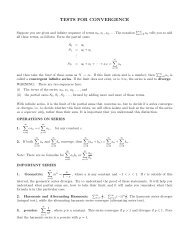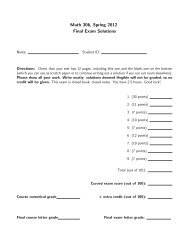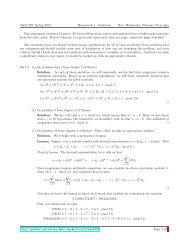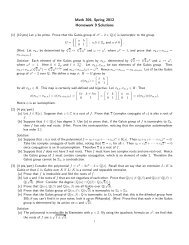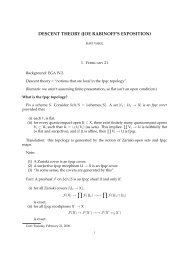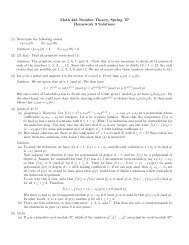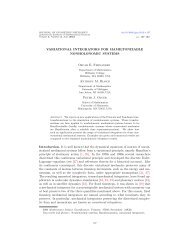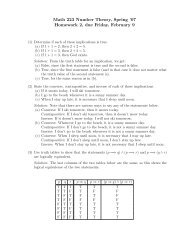CV - Wellesley College
CV - Wellesley College
CV - Wellesley College
Create successful ePaper yourself
Turn your PDF publications into a flip-book with our unique Google optimized e-Paper software.
Andrew C. Schultz106 Central Street, Department of Math, <strong>Wellesley</strong>, MA 02481andrew.c.schultz@gmail.comhttp://palmer.wellesley.edu/∼aschultzEmployment<strong>Wellesley</strong> <strong>College</strong>Assistant Professor of Math (July 2010-present)University of Illinois, Urbana-ChampaignJ.L. Doob Research Assistant Professor (August 2007-July 2010)EducationStanford University, Stanford, CAPh.D. in Mathematics, June 2007M.S. in Mathematics, June 2005Thesis Advisor: Ravi VakilThesis Title: Galois module structure of Galois cohomologyDavidson <strong>College</strong>, Davidson, NCB.S. magna cum laude, May 2002High Honors in MathematicsThesis Advisor: John SwallowResearch InterestsGalois and étale cohomology groups; Galois theories of rings and schemes; Embedding problems; Hilbert 90 and itsgeneralizations; q-binomial generalizations of binomial congruences; Ice models and alternating sign matricesHonors and AwardsDistinguished Teaching Award in Mathematics for Non-Tenure-Track Faculty, UIUC (2010)List of Teachers Rated Excellent, UIUCAbstract Linear Algebra (Spring 2010), Calculus II (Spring 2009), Elementary Number Theory (Fall 2008,Spring 2009), Applied Linear Algebra (Spring 2008), Introductory Matrix Theory (Fall 2007)Project NExT Fellow, 2008-2009.Centennial TA Award, Stanford 2007.The awards honor outstanding instruction by teaching assistants in the schools of Humanities and Sciences, EarthSciences, and Engineering.Finalist for the American Institute of Mathematics (AIM) 5-year fellowship 2007.The AIM 5-year fellowship is “intended for an absolutely first-rate new PhD — someone with the potential toleave a lasting mark on Mathematics.” (From the AIM website)Second Honors, Davidson <strong>College</strong> 2002.Given to the student with the second-highest overall GPA at graduation.
Research papers in print• J. Berg, A. Schultz. p-groups have unbounded realization multiplicity. Accepted by Proc. of the AMS.• A. Schultz. Parameterizing solutions to any Galois embedding problem over Z/p n Z with elementary p-abeliankernel. Accepted pending revisions by J. Algebra.• A. Schultz, R. Walker. A generalization of the Gaussian formula and a q-analog of Fleck’s congruence. J. NumberTheory. 133 (2013), 3717-3738.• J. Mináč, A. Schultz, and J. Swallow. Cyclic algebras, Schur indices, norms and Galois modules. Annales desSciences mathématiques du Québec. 35 (2011), no. 1, 123–136.• N. Lemire, J. Mináč, A. Schultz, and J. Swallow. Galois module structure of Galois cohomology for embeddablecyclic extensions of degree p n . Journal of the London Mathematical Society. 81 (2010), no. 3, 525–543.• N. Lemire, J. Mináč, A. Schultz, and J. Swallow. Hilbert 90 for Galois cohomology. Communications in Algebra.38 (2010), 361–372.• J. Mináč, A. Schultz, and J. Swallow. Automatic realizations of Galois groups with cyclic quotient of order p n .Journal de Theorie des Nombres de Bordeaux 20 (2008), 419–430.• J. Mináč, A. Schultz, and J. Swallow. Galois module structure of Milnor K-theory mod p s in characteristic p. NewYork Journal of Math. 14 (2008), 225–233.• R. Dwilewicz, J. Mináč, A. Schultz, and J. Swallow. Hilbert 90 for biquadratic extensions. Amer. Math. Monthly.114:7 (2007), 577–587.• D. Grynkiewicz, A. Schultz. A five color zero-sum generalization. Graphs and Combinatorics. 22:3 (2006), 351–360.• J. Mináč, A. Schultz, and J. Swallow. Galois module structure of pth-power classes of cyclic extensions of degreep n . Proc. London Math. Soc. 92 (2006), 307–341.• A. Schultz. On a modification of a problem of Bialostocki, Erdös, and Lefmann. Discrete Math. 306 (2006),244–253.Other papers• A. Schultz. Meta-Morphism: From graduate student to networked mathematician. Notices of AMS. 57 (2010),no. 7, 1132–1135. Appears in The Best Writing in Mathematics 2011. Princeton, NJ: Princeton Univ. Press, 2011,35–42.• G. Hurst, A. Schultz. An elementary (number theory) proof of Touchard’s congruence. Available at http://front.math.ucdavis.edu/0906.0696.Papers under review or in preparation• B. Brubaker, A. Schultz. The 6-vertex model and deformations of the Weyl character formula. In preparation.• D. Ernst, A. Hodge, A. Schultz. An inquiry-based learning approach to enhancing proof writing skills via crossinstitutionalpeer review. Submitted.• S. Chebolu, J. Mináč, A. Schultz. Non-abelian Galois groups of order p 3 , Galois modules and the norm residuehomomorphism. In preparation.
12/04 Workshop on Galois Modules, Galois Cohomology, pro-p groups and related topics, University ofWestern Ontario. Galois module structure of pth power classes, I, II & III.12/04 AIM/Stanford Number Theory Seminar. Applications and interpretations of the module structure of pthpower classes for cyclic extensions.10/03 Quadratic Forms, Algebraic Groups and Galois Cohomology, Banff International Research Station. Galoismodule structure of pth power classes of cyclic extensions of degree p n .09/03 Math Coffee Lectures, Davidson <strong>College</strong>. Mathematical evolution: a tour through paradox.03/02 Southeast Regional Meeting on Numbers, Furman University. Galois module structure of pth power classesof cyclic extensions of degree p n .01/02 AMS/MAA Joint Meetings, Special Session on Undergraduate Research, San Diego, CA. Recursive r-coloringsand monochromatic substructures of the positive integers.Courses TaughtNumerical Analysis. <strong>Wellesley</strong> <strong>College</strong>, Spring 2013.Abstract Algebra. <strong>Wellesley</strong> <strong>College</strong>, Spring 2012, Fall 2012.Complex Analysis. <strong>Wellesley</strong> <strong>College</strong>, Fall 2011, Fall 2012.Mathematical Thought & Proof. <strong>Wellesley</strong> <strong>College</strong>, Spring 2012.This is a first year seminar taught using IBL that introduces students to the standard practices and expectations inhigher level math classes. The course shows students fundamental proof techniques and foundational mathematicalobjects used in subsequent math courses.Multivariable Calculus. <strong>Wellesley</strong> <strong>College</strong>, Spring 2011.Elementary Number Theory. UIUC, Fall 2008 and Spring 2009; <strong>Wellesley</strong> <strong>College</strong>, Spring 2011, Spring 2013.Calculus II. UIUC, Spring 2009; <strong>Wellesley</strong> <strong>College</strong>, Fall 2010 and 2011, Summer 2013.Applied Linear Algebra (Calculus & Mathematica section). UIUC, Spring 2008, Fall 2009.Calculus & Mathematica courses are active-learning courses designed around interactive Mathematica notebooks.The applied linear algebra course takes a geometric perspective on linear algebra via the singular value decompositionand focuses particularly on applications of the subject.Introductory Matrix Theory (“Traditional” sections). UIUC, Fall 2007.Introductory Matrix Theory (Calculus & Mathematica section). UIUC, Fall 2007.Stanford Summer Engineering Academy, Mathematics Module. Stanford, Summer 2006.The Stanford Summer Engineering Academy is designed to help attract and maintain diversity in the School ofEngineering by providing an introduction to engineering, mathematics and physical sciences at Stanford. Themathematics module prepares students for either linear algebra and multivariable calculus or single variablecalculus by introducing material they will see during the regular term. I designed and taught both four weekcourses.Matrix Theory and its Applications. Stanford, Summer 2006.Calculus. Stanford, Winter 2005 and 2006.
Additional teaching activities• Directed undergraduate research– Worked with Chip Hurst on recursive formulae for Bell Numbers. Resulted in “An elementary (number theory)proof of Touchard’s Congruence.” (Spring 2008)– Supervised Jen Berg’s senior thesis project concerning Galois module structure for Artin-Schreier Theory.Resulted in “p-groups have unbounded realization multiplicity.” (Fall 2009)– Led independent study for Joe Nance on continued fraction expansions of surds. (Fall 2009)– Supervised Robert Walker in the Student Research Opportunities Program. Resulted in “A generalization ofthe Gaussian formula and a q-analog of Fleck’s congruence.” (Summer 2010)– Supervised Melinda Lanius’ senior thesis project on universal cycles for k-subsets. (2011-2012)– Supervised Ran Ji’s senior thesis project on enumerating alternating sign matrices. (2012-2013)– Supervised a research project with Farrah Yhee on sharpness results for q-binomial congruences. (2012-2013)• Led the <strong>Wellesley</strong> Putnam problem seminar and administered the Putnam exam. (Fall 2010, 2011, 2012)• Coordinated the <strong>Wellesley</strong> student seminar. (Spring 2010, 2011)• Led weekly problem solving sessions for 4th and 5th grade students at Booker T. Washington Elementary Schoolin Urbana, IL, in preparation for the Math Olympiad (Fall 2009)• Authored supplementary content in the Matrices, Geometry & Mathematica courseware for the linear algebrasections of Calculus & Mathematica, including additional discussion/homework problems and an exposition ofGoogle’s PageRank algorithm.• Together with Rob Easton, designed and wrote MatLab computer labs for Stanford’s introductory linear algebra,multivariable calculus and vector calculus courses. Assignments are available on my webpage.• Participated in Stanford’s Writing in the Major program as a grader for three different math classes. Each class hada writing component which required students to submit one long (or several short) expository papers on varioustopics. As grader and writing coach, I was responsible for helping students write clear, concise and compelling work.• Course assistant for 6 classes while a graduate student at Stanford. Courses ranged from introductory calculus tograduate algebra.• Teaching assistant for 3 classes while a graduate student at Stanford. Courses covered introductory linear algebra,multivariable calculus and vector calculus.• Assistant Director for Arie Bialostocki’s REU at the University of Idaho in the summer of 2002. My role was tohelp coordinate student activities and amenities as well as to provide stimulation for their own research projects. Ialso assisted students as they wrote up their research results.Computer and Programming ProficiencyMathematica, MatLab, Java, L A TEX, HTML, Linux, SageReferencesRavi Vakil (advisor)Department of Mathematics, Stanford Universityvakil@math.stanford.edu
Ján MináčDepartment of Mathematics, University of Western Ontariominac@uwo.caBruce ReznickDepartment of Mathematics, University of Illinois, Urbana-Champaignreznick@math.uiuc.eduJohn SwallowProvost, The University of the South (Sewanee)jrswallo@sewanee.eduAnn TrenkDepartment of Mathematics, <strong>Wellesley</strong> <strong>College</strong>atrenk@wellesley.edu



